

Welsh Triads. The Welsh Triads (Welsh Trioedd Ynys Prydein, literally "Triads of the Island of Britain") are a group of related texts in medieval manuscripts which preserve fragments of Welsh folklore, mythology and traditional history in groups of three.
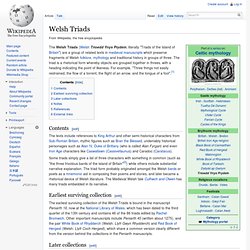
The triad is a rhetorical form whereby objects are grouped together in threes, with a heading indicating the point of likeness. For example, "Three things not easily restrained, the flow of a torrent, the flight of an arrow, and the tongue of a fool".[1] Contents[edit] The texts include references to King Arthur and other semi-historical characters from Sub-Roman Britain, mythic figures such as Bran the Blessed, undeniably historical personages such as Alan IV, Duke of Brittany (who is called Alan Fyrgan) and even Iron Age characters like Caswallawn (Cassivellaunus) and Caradoc (Caratacus). Earliest surviving collection[edit] Later collections[edit] Notes[edit] References[edit] Rachel Bromwich, editor and translator. Book of Taliesin. The Book of Taliesin (Welsh: Llyfr Taliesin) is one of the most famous of Middle Welsh manuscripts, dating from the first half of the 14th century though many of the fifty-six poems it preserves are taken to originate in the 10th century.
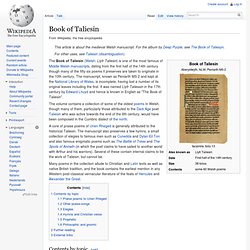
The manuscript, known as Peniarth MS 2 and kept at the National Library of Wales, is incomplete, having lost a number of its original leaves including the first. It was named Llyfr Taliessin in the 17th century by Edward Lhuyd and hence is known in English as "The Book of Taliesin". The volume contains a collection of some of the oldest poems in Welsh, though many of them, particularly those attributed to the Dark Age poet Taliesin who was active towards the end of the 6th century, would have been composed in the Cumbric dialect of the north. A core of praise poems of Urien Rheged is generally attributed to the historical Taliesin. Contents by topic[edit] Titles adapted from Skene. Praise poems to Urien Rheged[edit] Other praise-songs[edit] Mabinogion. The Two Kings (sculptor Ivor Robert-Jones, 1984) near Harlech Castle, Wales.

Bendigeidfran carries the body of his nephew Gwern. The Mabinogion (Welsh pronunciation: [mabɪˈnɔɡjɔn]) is the title given to a collection of eleven prose stories collated from medieval Welsh manuscripts. The tales draw on pre-Christian Celtic mythology, international folktale motifs, and early medieval historical traditions. While some details may hark back to older Iron Age traditions, each of these tales is the product of a highly developed medieval Welsh narrative tradition, both oral and written. Breton mythology. Breton mythology is the mythology or corpus of explanatory and herioc tales originating in Brittany, now in France.
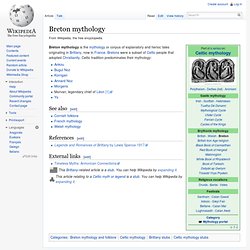
Bretons were a subset of Celtic people that adopted Christianity. Celtic tradition predominates their mythology: See also[edit] References[edit] Legends and Romances of Brittany by Lewis Spence 1917 External links[edit] Timeless Myths: Armorican Connections. Welsh mythology. The prose stories from the White and Red Books are known as the Mabinogion, a title given to them by their first translator, Lady Charlotte Guest, and also used by subsequent translators.
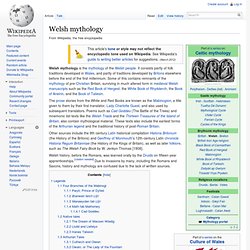
Poems such as Cad Goddeu (The Battle of the Trees) and mnemonic list-texts like the Welsh Triads and the Thirteen Treasures of the Island of Britain, also contain mythological material. Matter of Britain. The Matter of Britain is a name given collectively to the body of medieval literature and legendary material associated with Great Britain, and sometimes Brittany, and the legendary kings and heroes associated with it, particularly King Arthur.
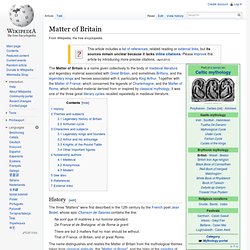
Together with the Matter of France, which concerned the legends of Charlemagne, and the Matter of Rome, which included material derived from or inspired by classical mythology, it was one of the three great literary cycles recalled repeatedly in medieval literature. History[edit] The three "Matters" were first described in the 12th century by the French poet Jean Bodel, whose epic Chanson de Saisnes contains the line: Ne sont que III matières à nul homme atandant, De France et de Bretaigne, et de Rome la grant. There are but 3 matters that no man should be without, British Iron Age.